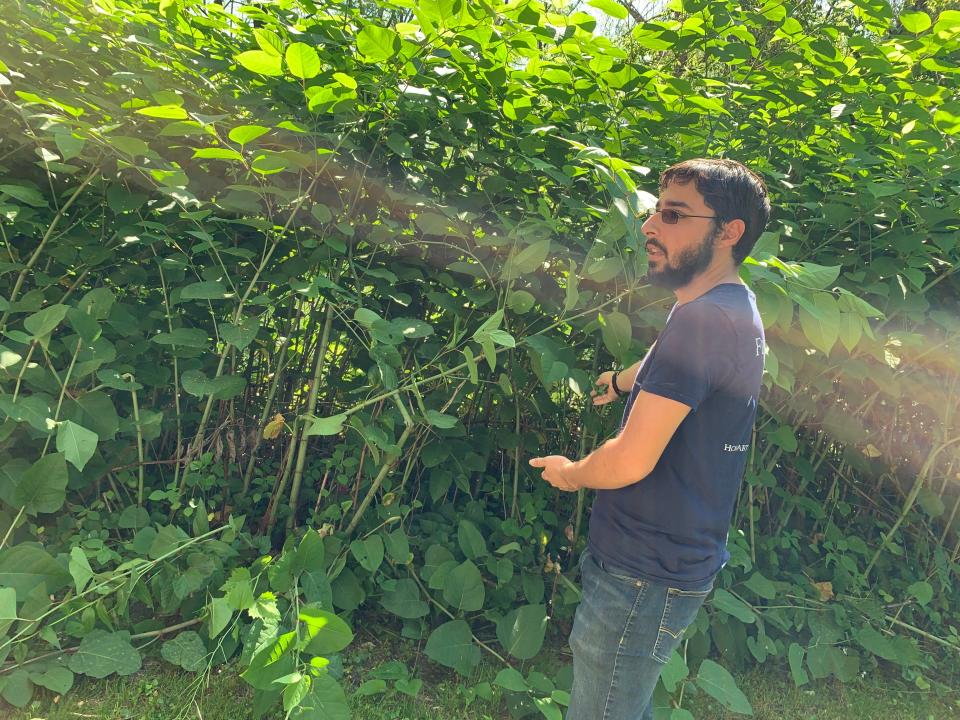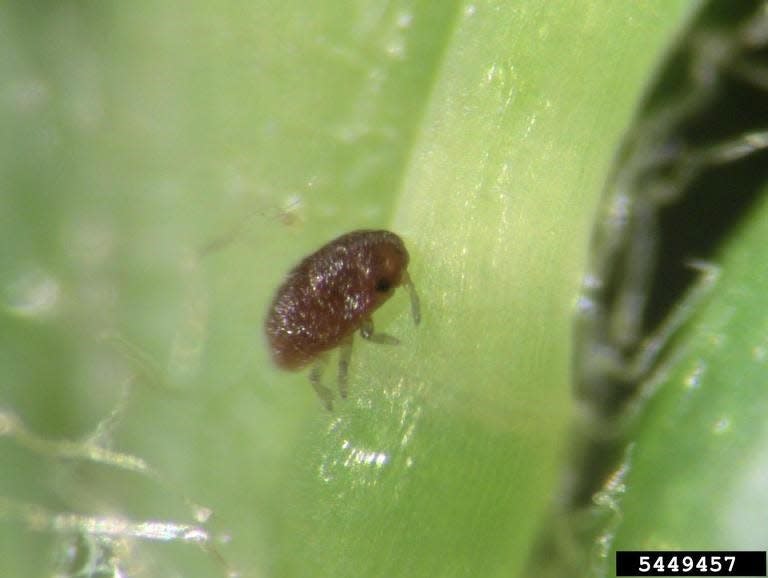This teeny-tiny pest can cause big-time damage. What you should know about the invasive hemlock woolly adelgid
The hemlock woolly adelgid is a teeny-weeny little pest - an adult is about the width of a human hair – but the invasive species can do big-time damage.
This woolly bully feeds on hemlock trees and, eventually, can kill them in large numbers, leading to ripple effects for other plants, animals and humans, according to Matt Gallo, terrestrial invasive species coordinator for Finger Lakes Institute – Finger Lakes PRISM at Hobart and William Smith Colleges in Geneva.
The hemlock woolly adelgid, or HWA as it’s known, is an accidental arrival to the United States, potentially arriving on multiple shipments of infested plants from Japan in the early 20th century. Since the first established population was found in Virginia in 1951, the HWA has spread both north and south throughout the range of the eastern hemlock, arriving in New York in the 1980s and only really starting to reach into the Finger Lakes region in the 2000s, Gallo said.
Gallo explains more about the hemlock woolly adelgid, how it affects people who live in the Finger Lakes, its impact on Canandaigua Lake, and what can be done about this invasive species.
Q: How did you get into this field and end up knowing so much about the hemlock woolly adelgid?

Gallo: I always had a passion for the environment so it was a very natural career path for me. I truly couldn't think of anything else I wanted to do when I went to college than something vaguely in "the environment."
In terms of how I got so involved with invasive species, they're a massive problem so it's something that's hard to ignore. I took some courses in college and had an internship on invasive species and worked on some invasive species projects in my first job out of school. All of that experience ended up funneling me more and more into invasive species.
Q: How can such a tiny thing be so destructive?
Gallo: Big things come in small packages and that is certainly the case with HWA. Even though they are tiny, they make up for their size just in sheer force of numbers. HWA feeds on the xylem of the hemlock in a way that is similar to what other insects like aphids do. They're not chewing on the needles or anything like that; just feeding on the xylem. As HWA feeds and takes away the tree's energy reserves, that infested tree won't be able to put on new growth, so one of the earlier signs of an infestation is lack of spring needle growth.
As a response to this feeding, the hemlock actually will have an over-reactive immune response and cut off nutrient flow to the infested twigs. The problem is that it doesn't do much to actually stop the adelgids, so the tree keeps cutting off circulation of nutrients to more and more needles, as HWA continues to deplete it of more and more energy.
Combined, this eventually kills the tree.
Q: Why are hemlocks so important to Canandaigua Lake and the watershed?

Gallo: Hemlocks are the third most common tree in New York, so we're talking about losing a lot of trees if we lost them all.
Hemlocks are also what we consider a keystone species in ecology. That means that they have a large impact on a lot of other species around them. Hemlocks are unique among our conifers here in New York because unlike our pines and spruces, hemlocks are an incredibly shade-tolerant species; in fact, they actually cast the most amount of shade of any tree we have in our region. What this means is that conditions underneath a hemlock canopy are often quite different than under other tree canopies and typically you find much cooler temperatures and much more water.
These are perfect conditions for our state fish the brook trout, which heavily rely on these conditions. Lots of birds, amphibians, insects, and plants only grow where hemlocks grow, so if we lose hemlocks, we're losing things like the black-throated green warblers too. There's also a species of fungus called Ganoderma, or reishi, that exclusively grows on hemlock wood. Some research shows this mushroom makes compounds that are antiviral, antibacterial, anti-inflammatory, and even reduce cancer risk. With the loss of our hemlocks, we could lose drugs that could change a lot of people’s lives.
Hemlocks also love to grow on steep slopes, and in many cases throughout the Finger Lakes, hemlocks might be the only tree growing on a particular slope. This keeps our cliffsides intact and prevents a ton of erosion from entering our waterways. If we lose our hemlocks, it could dramatically reshape what the hills around Canandaigua look like.
Q: Have efforts to eradicate HWA been successful? If not, what more can be done?
Gallo: There are quite literally trillions of adelgids in North America - they're not going away anytime soon. Our focus right now is to monitor the impact of how and where they are spreading to, so we can treat new populations of HWA as soon as they arise. This can be done with either pesticides or biocontrols. A biocontrol is a nonnative predator brought in to control an invasive species. Cornell has been doing research into some biocontrols for over a decade now, and the hope is that these predators will be able to control the HWA population in the long term.
Q: What else should we know about HWA?
Gallo: I think it's important for people to know that if this is something that they're worried about it doesn't have to be all doom and gloom.
Anyone who feels like they want to help absolutely can. We have a volunteer HWA detection survey where we train volunteers to go out and find new populations of HWA on their own, so I can't overstate just how important it is to have volunteers being our eyes out there and helping us keep track of HWA. We can't make any control decisions if we don't know where HWA is and isn't - that's just a fact.
This year, one of our volunteers found a new population of HWA at Bristol Mountain Ski Resort, so already our volunteers are paying dividends We don't have the capacity to be everywhere and survey every hemlock tree, so if people want to help they can survey for hemlocks and find new populations of HWA, and find sites where Cornell might be able to release their biocontrol. Who knows, maybe they'll even find a hemlock that's immune to HWA. Anyone interested in helping out can email gallo@hws.edu or go to http://fingerlakesinvasives.org/invasive-survey//.
This article originally appeared on Rochester Democrat and Chronicle: Hemlock woolly adelgid can cause big-time damage. What to know

